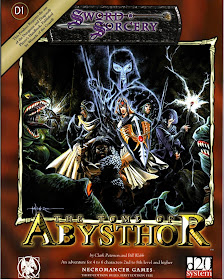One of the practical considerations when running a tabletop RPG is "do we need a map?"
I've run superhero games where we really didn't use anything to keep track of where people and things were because it was easier to keep them in our heads. We might have miniatures to represent our heroes and some for the badguys, but that's mainly to keep up with who is where in a general sense - character A is at the bank robbery, character B is at the big fire, and character C is at the city jail.
For most D&D type games though, the answer is yes. People moving and fighting in confined spaces means it's often good for everyone to know just where everyone is.
For those, for a very long time, the solution has been the good old Chessex mat - erasable, flexible, portable.I have 3 of them and they are the standard by which I judge other solutions. I've played every edition of D&D on them at some point, along with Pathfinder, Champions, GURPS, Star Wars, Deadlands, and a bunch of other stuff that was popular in the 80's & 90's.
When I was looking at starting a new D&D game with a new edition of the rules I decided to try something newer so I got this:
It's a Hexers RPG board (you can find them on
Amazon) and along with a set of multicolor dry erase markers it makes for a nice change from the more limited palette of my wet erase markers. It's a fold-up hard board and has hexes on the other side so it's useful for a variety of games.
Now I thought that having a white background would be more like drawing things out on paper but in practice I find that's too bright for D&D type games. I'm so used to the parchment colored background of the chessex mat that the bright clean white with bold black lines looks too high tech in some weird way. For modern, sci-fi, or superheroes I think it will be fine but for D&D it really throws me off.
It's also smaller than my chessex mat so I feel a little constrained when the party goes exploring.The heavy borders make it hard to join up with another map too.
A possible middle ground is the new item from WOTC:
This is the "
D&D Adventure Grid" and it's also reversible, though in a different way:
With a green grassy-looking background on one side and a grey stone look on the other it's pretty versatile as long as all you need is a square grid. Also note: no border so we could add on additional boards though the edge squares are not full squares. I'm thinking about getting one or two more and maybe cutting one of them into sections to add even more flexibility. I really like this one and I'll be trying it out this weekend for the first time.
Now I am not generally a fan of dungeon tiles but there is one set where I make an exception:
These are from the Star Wars Galaxy Tiles that WOTC published when they were doing Star Wars d20, I have 2 or 3 sets of them.
My problem with Dungeon Tiles in general is that while they are handy for those dungeon passageways we all know and love they tend to cripple creativity when it comes to rooms and details in general. I find people start defining towns and dungeons by what pieces they have which is as bad a case of the tail wagging the dog as I can think of. If I am running a published adventure I can guarantee that there will be at least a few things I cannot recreate with tiles and I hate having to intermix printed tiles with hand-drawn paper or mats.
The reason I like the Star Wars tiles is that the universe has a fairly specific look to it, particularly Imperial facillities, and the tiles enhance that by presenting that same look. No, I would not use them for a battle in a desert canyon on Tattooine (I'd use the Chessex mat!), or the forests of Endor (I'd use the green map above) or Hoth (I'd use the white one above!) but for ship interiors, and Imperial base interiors - something that tends to come up quite a bit in a Star Wars campaign - they are really handy and so avoid those issue I have with tiles in general.
What about Dwarven Forge? - just a more expensive version of tiles to me. I already have a fair amount of miniature terrain for actual miniatures games and when it fits I use it - see above. I am not looking to spend much more on what are in the end miniatures-optional games.
There are also poster maps and flip-mats and they do have their uses. I have a ton of poster maps from my 4E adventures and some of them I have used a dozen times while others I have never used at all. They're sort of like bigger dungeon tiles - useful when they fit but not something to tie yourself to. The Paizo flip-mats tend to be more broadly useful but since they are a standalone purchase I have far fewer of them.
What about the monitor-as-tabletop option? One of these days. I feel that you have to build your table around the whole thing and I am not really looking to undertake that challenge just yet. There are so many maps available in electronic format that it makes a lot of sense.
For now though, I have yet to find anything that is as flexible as the tried and true pens-and-a-drawing-surface approach that we've been using for decades. That said, it's good to have options.






















































